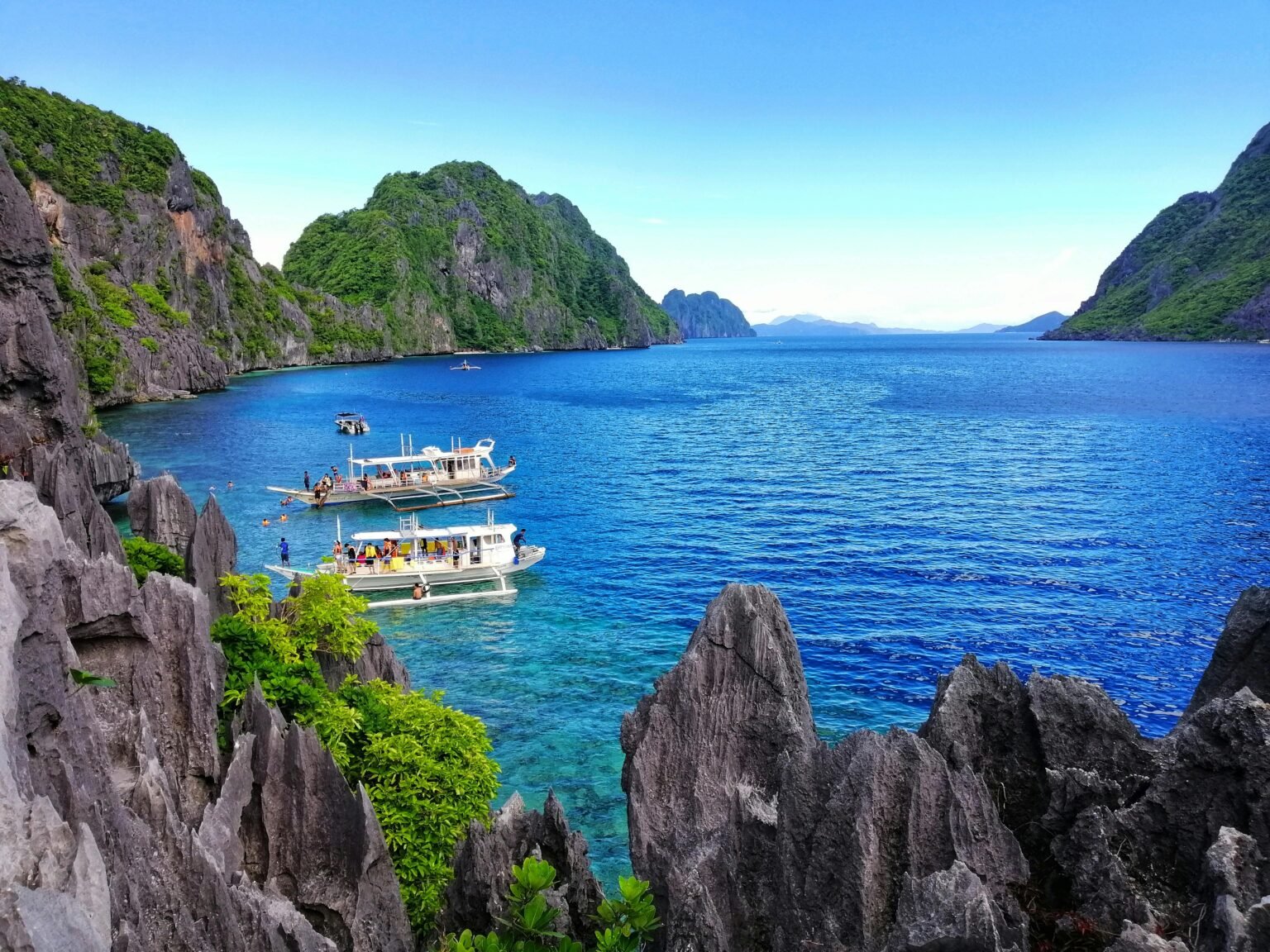Looking for an easy, exciting, and unforgettable trip? This Philippines travel guide is your perfect starting point. Made up of over 7,600 islands, the Philippines is a place where white-sand beaches, jungle adventures, and rich culture come together. It’s ideal for all kinds of travelers—whether you’re a digital nomad searching for your next work-and-play spot, or a first-timer ready to explore island life.
In this easy-to-follow Philippines travel guide, you’ll find:
- The best places to visit
- When to go
- Local tips that make planning stress-free
- And how to stay connected with a Gohub travel eSIM—no roaming, no SIM cards, just instant data
Let’s get you ready for one of Southeast Asia’s most beautiful (and underrated!) destinations.
The divine flame of thought is inextinguishable in the Filipino people, and somehow or other it will shine forth and compel recognition. It is impossible to brutalize the inhabitants of the Philippines!
Jose Rizal
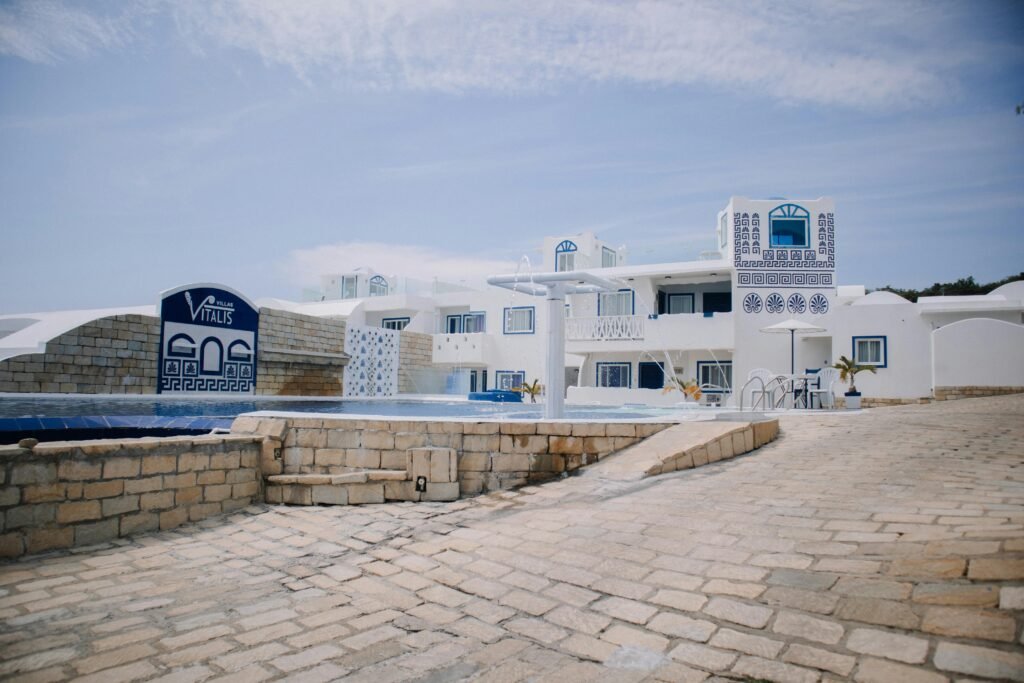
Image: Charming White Beach Resort in the Philippines
I. Why Choose the Philippines for Your Next Adventure
The Philippines isn’t just another tropical escape—it’s a country full of surprises, warm people, and one-of-a-kind adventures. Whether you love nature, culture, or simply chilling on a white-sand beach, here’s why traveling to the Philippines should be at the top of your list:
Unparalleled Island Diversity
With over 7,600 islands, the Philippines is bursting with diversity. One day you’re swimming in turquoise lagoons in Palawan, the next you’re standing on the otherworldly Chocolate Hills in Bohol. Each island feels like its own little world—and that means nonstop adventure.
The Kindest Locals You’ll Ever Meet
Filipinos are famous for their warmth and hospitality. People here don’t just smile—they go out of their way to help. Ask for directions and you might end up with a full-blown local food recommendation (plus a new friend).

Image: Warm Filipino Hospitality
Excellent English Proficiency
Worried about the language barrier? No need. English is widely spoken across the country, especially in cities and tourist areas. Ordering food, asking for help, or booking a boat ride? Simple.
Budget-Friendly Travel Experience
From beachfront hostels to tasty street food, the Philippines is one of the best budget destinations in Asia.
You can island-hop, surf, dive, and eat well—without spending a fortune. Perfect for backpackers, digital nomads, and long-term explorers.
📱 Pro Tip: If you’re moving between islands or remote towns, staying connected can be tricky. A Gohub travel eSIM gives you fast, affordable data across the country—no roaming, no stress.
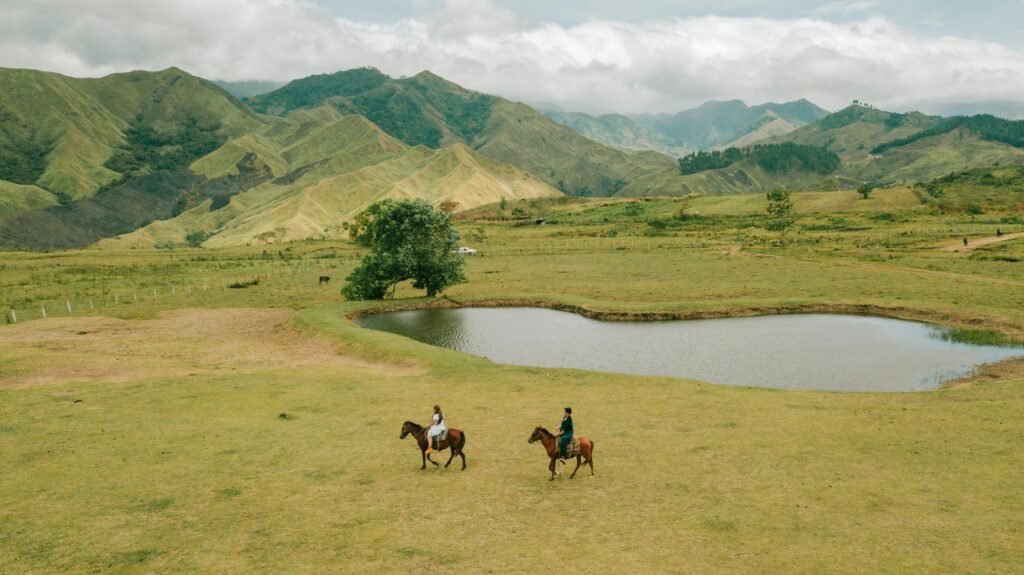
Image: Scenic Horseback Ride in Northern Mindanao
II. Best Time to Visit Philippines: Seasonal Considerations
Choosing the best time to visit the Philippines depends on what kind of trip you’re planning. The country has two main seasons—dry and wet—and each offers something unique.
Dry Season (November to May)
If you want sunshine and clear skies, this is your go-to window.
The best weather in the Philippines happens from December to February—cooler mornings, low humidity, and barely any rain.
Perfect for:
- Island hopping in El Nido or Coron
- Beach time in Boracay
- Hiking volcanoes or rice terraces
- Joining lively local festivals like Sinulog or Ati-Atihan
👉 Pro Tip: It’s also the busiest season, so book early—especially flights and ferries between islands.
Wet Season (June to October)
This time brings more rain, especially between July and September, and the chance of typhoons. But don’t rule it out yet.
Why visit during the wet season?
- Fewer tourists = quieter beaches
- Lush, green scenery for nature lovers
- Great deals on hotels and tours
- Cebu and Bohol still get plenty of sun!
Just bring a light rain jacket and a sense of adventure 🌿
📱 Travel Tip: Weather can shift fast in island regions. Having a Gohub travel eSIM helps you check forecasts, rebook ferries, or stay in touch with your homestay—on the fly, no roaming charges.
III. Top Philippines Attractions: Island by Island Guide
With over 7,000 islands, planning a trip to the Philippines can feel overwhelming. Don’t worry—we’ve narrowed it down to the most stunning spots. This Philippines island guide will help you find the best places to visit based on your time and travel style.
Palawan: The Last Frontier of Natural Beauty
Consistently ranked among the world’s best islands, Palawan offers pristine natural beauty that captivates even the most jaded travelers. The island’s key attractions include:
- Puerto Princesa Underground River: This UNESCO World Heritage Site is a huge cave with a river inside. You’ll take a small boat through 8 kilometers of amazing rock shapes and dark, echoing tunnels.
- El Nido: Known for tall cliffs, blue lagoons, and secret beaches. It’s great for island hopping. Join a boat tour to visit popular spots like Big Lagoon and Secret Beach.
- Coron: A top choice for diving. You can explore sunken ships from World War II, swim in clear lakes, and see colorful coral reefs.
- Nacpan Beach: A quiet beach with 4 kilometers of golden sand. It’s less crowded than other spots and perfect for relaxing.
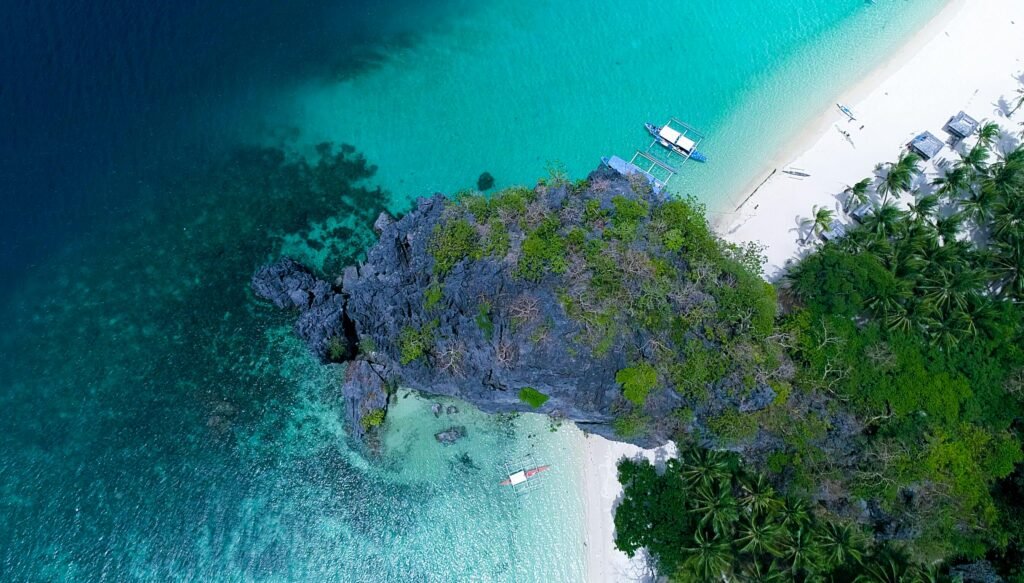
Image: El Nido, MIMAROPA, Philippines
Palawan is ideal for travelers seeking ecotourism experiences, underwater adventures, and pristine natural environments relatively untouched by mass tourism.
Boracay: White Beach Paradise
This Boracay travel guide wouldn’t be complete without its star: White Beach. Though small, Boracay is one of the top beach destinations in the Philippines, famous for its powdery sand and fun island vibe.
- White Beach: The island’s main attraction. This 4-kilometer beach has incredibly fine sand and crystal-clear water. It’s perfect for swimming, watching the sunset, or just chilling under a coconut tree.
- Puka Shell Beach: A peaceful spot on the north side of the island. It’s less crowded and known for its natural beauty and puka shells that line the shore.
- Water Sports: If you’re into adventure, Boracay offers kiteboarding, parasailing, paddleboarding, and snorkeling—all easy to book along the beach.
- Vibrant Nightlife: After dark, the island comes alive. Enjoy fire dancers, live music, beachfront bars, and all kinds of local and international food.

Image: Boracay, Philippines
Following its rehabilitation in 2018, Boracay now balances tourism with environmental sustainability, offering a more refined beach paradise experience.
Cebu: Cultural Heritage Meets Island Adventure
No Philippines travel guide is complete without a stop in Cebu—a place where history, nature, and ocean adventures come together. Whether you’re into culture, waterfalls, or marine life, Cebu has it all.
- Magellan’s Cross and Fort San Pedro: These landmarks in Cebu City tell the story of the Philippines’ colonial history. They’re must-visits for anyone curious about the country’s Spanish roots.
- Kawasan Falls: A favorite for thrill-seekers. Try canyoneering through rivers and jungle trails before jumping into the bright blue pools of Kawasan.
- Moalboal: Swim alongside millions of sardines just meters from shore. This epic sardine run is one of Cebu’s most unique natural sights.
- Oslob: Known for whale shark watching. While the practice is debated, many still visit to swim with these gentle giants.
- Malapascua Island: A small island that’s a big hit with divers. It’s one of the few places in the world where you can often see thresher sharks.
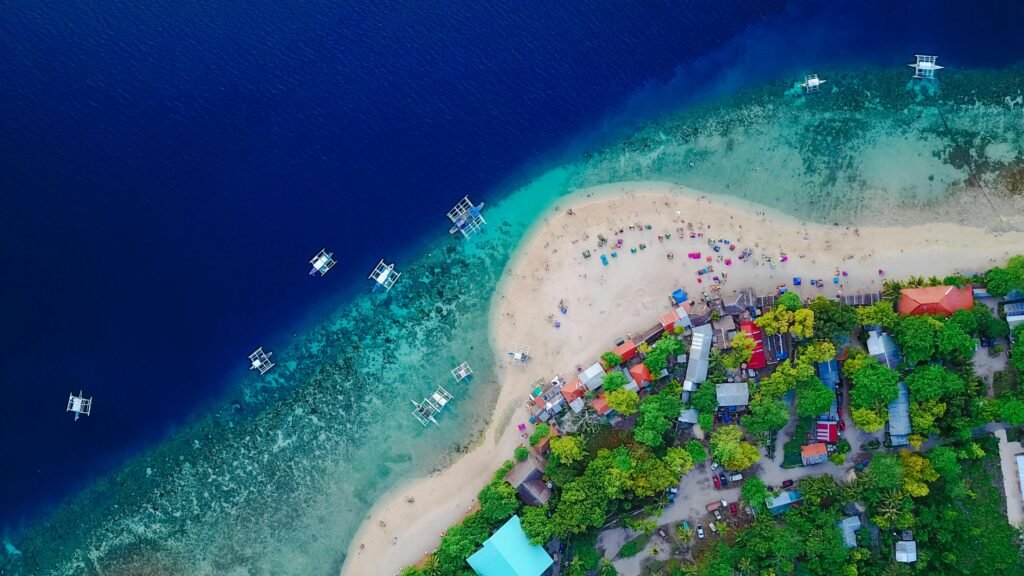
Cebu’s central location in the Visayas makes it an excellent base for exploring neighboring islands, while its international airport provides convenient access for travelers.
Bohol: Natural Wonders and Wildlife Encounters
Bohol is a must-add to any Philippines travel guide. It offers a unique mix of strange landscapes, rare wildlife, and peaceful beaches—perfect for travelers who want to slow down but still explore.
- Chocolate Hills: These over 1,200 cone-shaped hills turn brown in the dry season—making them look like giant chocolate drops. It’s one of the most unusual sights in the country.
- Philippine Tarsier Sanctuary: See one of the smallest primates in the world in their natural habitat. This peaceful conservation area helps protect the shy and wide-eyed tarsier.
- Panglao Island: Connected to Bohol by a bridge, this island is home to Alona Beach and several quiet white-sand spots. It’s also great for diving and snorkeling.
- Loboc River Cruise: Enjoy a local meal on a floating restaurant while cruising down the calm, green Loboc River—often with live music on board.
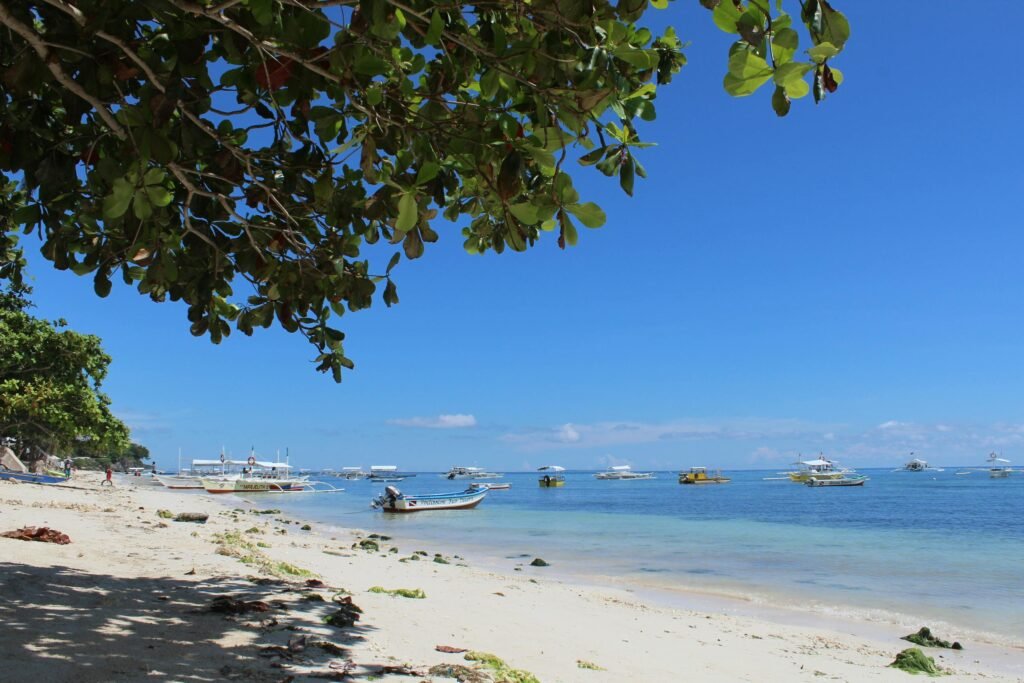
Bohol is less crowded than other islands but still full of fun and natural beauty. It’s a great pick for families, couples, and nature lovers looking for variety and a slower pace.
Siargao: The Surfing Capital of the Philippines
No Philippines travel guide is complete without Siargao—a teardrop-shaped island known for its surf culture, island vibes, and raw natural beauty. It’s perfect for both surfers and laid-back travelers looking for something real and unfiltered.
- Cloud 9: Siargao’s most famous surf spot. This world-class reef break draws surfers from around the world, especially during peak season (September–November).
- Sugba Lagoon: A calm, emerald-green lagoon surrounded by limestone cliffs. Ideal for paddle boarding, kayaking, or taking a quiet swim.
- Magpupungko Rock Pools: These natural tidal pools show up at low tide—great for swimming, cliff-jumping, and unique photos.
- Island Hopping: Hop between Naked Island, Daku Island, and Guyam Island—three small, beautiful islands with clear water and soft white sand.

Siargao’s laid-back atmosphere, coupled with its natural beauty, has made it increasingly popular among digital nomads and travelers seeking longer stays in the Philippines.
IV. Hidden Gems in Philippines: Off-the-Beaten-Path Destinations
The famous islands are amazing—but this Philippines travel guide wouldn’t be complete without a few secret spots. For travelers who like to go beyond the usual, these hidden gems in the Philippines are worth the extra journey.
Batanes: Northernmost Wonder
Tucked away at the very top of the Philippines, Batanes feels like a world of its own. With rolling green hills, dramatic cliffs, and stone houses, it looks more like Ireland than Southeast Asia.
The weather here can be rough, but the beauty and peace make it worth it. You’ll meet the Ivatan people, known for their kindness and strong community. Their culture has stayed intact for centuries—shaped by wind, waves, and resilience.
This is one of the most off-the-beaten-path destinations in the country, perfect for slow travel, quiet moments, and deep cultural connection.

Siquijor: Mystical Island Experience
Siquijor is one of the most mystical destinations in the Philippines, often skipped by first-timers—but that’s part of its charm. Known for folk healing traditions and a slightly spooky reputation, it offers a blend of mystery and natural beauty.
Things to see and do in Siquijor:
- Traditional Healing: Locals still practice herbal healing and spiritual rituals, passed down for generations. Some even open their homes for visitors to learn more—just ask respectfully.
- Cambugahay Falls: A short trek brings you to these multi-level waterfalls with clear turquoise pools. It’s perfect for cliff jumping or swinging into the water Tarzan-style.
- Balete Tree: This centuries-old tree is said to have magical energy. At its base, you’ll find a natural spring and fish spa—both relaxing and a little eerie.
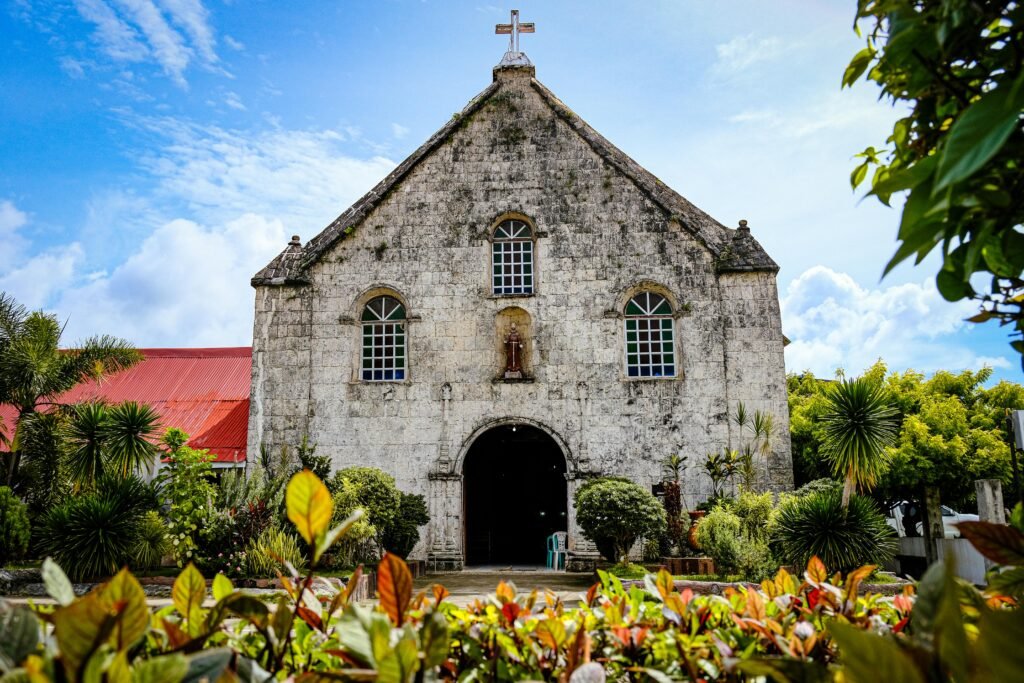
Camiguin: Island of Fire
Camiguin may be small, but it’s one of the most unique islands in the country. Known as the Island of Fire, it’s home to seven volcanoes, lush forests, and natural springs—all packed into one tiny island.
Top attractions in Camiguin:
- Volcano Views and Hikes: Hike around Mt. Hibok-Hibok, an active volcano, or simply enjoy the dramatic landscape shaped by centuries of eruptions.
- Hot and Cold Springs: Relax in warm pools at Ardent Hot Springs, or cool off in the Sto. Niño Cold Springs—both surrounded by greenery.
- Sunken Cemetery: One of the island’s most iconic sights. A large white cross marks the spot where a cemetery sank into the sea during a volcanic eruption in the 1870s. You can snorkel around the area or take a short boat ride for a closer look.
Romblon: Marble Capital and Beach Paradise
Romblon is one of the most peaceful and underrated islands in the country. Known as the Marble Capital of the Philippines, it also hides some of the most stunning beaches you’ve (probably) never heard of.
What to see in Romblon:
- Marble Craftsmanship: Romblon is known for producing world-class marble. You can visit local workshops and see how artisans turn stone into beautiful, handmade pieces.
- Bon Bon Beach: This picture-perfect beach is famous for its natural sandbar, which connects to a tiny island at low tide. The sand is powdery white, the water crystal clear—and the best part? No crowds.

V. Philippines Travel Tips: Essential Information for Travelers
Planning your trip is just the beginning—these essential Philippines travel tips will help you stay safe, connected, and stress-free from touchdown to island-hopping.
Connectivity Solutions for Travelers
Staying connected is essential for modern travelers, whether for navigation, translation, or sharing experiences. For reliable internet access throughout the Philippines:
- eSIM Solutions: Consider purchasing an eSIM before departure for immediate connectivity upon arrival. Gohub offers affordable eSIM packages specifically designed for travelers to the Philippines, providing high-speed data coverage across the archipelago without the hassle of physical SIM cards.
- Local SIM Cards: Available at airports and convenience stores, local SIMs from providers like Globe and Smart offer good coverage in tourist areas.
- Wi-Fi Availability: While widely available in hotels and restaurants in major tourist destinations, quality can vary significantly, especially on remote islands.
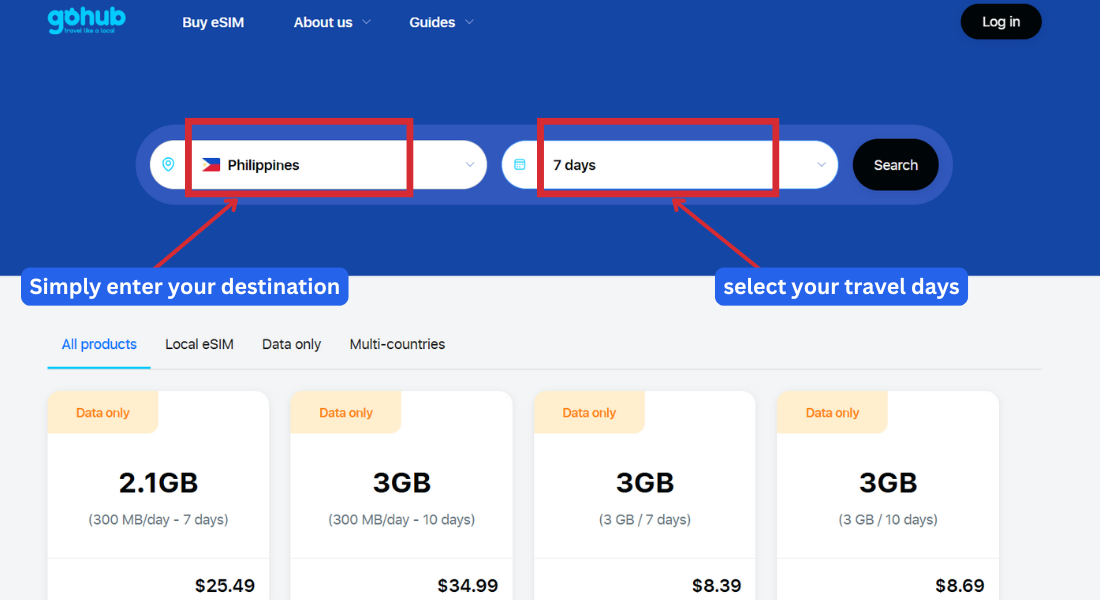
Image: Screenshot of the GoHub eSIM webpage, highlighting the destination input field with “Philippines” selected, illustrating how users can easily search for eSIM data plans.
👉 Explore GoHub’s Philippines eSIM plans now
Transportation Between Islands
Navigating the Philippine archipelago requires strategic planning:
- Domestic Flights: The fastest way to travel between major islands, with carriers like Cebu Pacific, Philippine Airlines, and AirAsia offering frequent connections. Book in advance for better rates.
- Ferries: For shorter distances between neighboring islands, ferries provide an affordable alternative. Companies like 2GO Travel and FastCat operate modern vessels on popular routes.
- Bangkas: Traditional outrigger boats used for island hopping and shorter crossings.
Local Transportation Options
Once on your destination island, consider these transportation methods:
- Jeepneys: Iconic converted military jeeps that serve as public transportation in cities and towns.
- Tricycles: Motorcycles with sidecars that function as local taxis for short distances.
- Grab: Available in major cities like Manila, Cebu, and Davao, providing convenient and reliable transportation.
- Motorbike Rentals: Popular on smaller islands like Siargao and Bohol, offering flexibility for exploration.
Accommodation Choices Across Budgets
The Philippines offers lodging options for every budget and preference:
- Budget Hostels: Starting from ₱300-800 per night, perfect for backpackers and solo travelers.
- Mid-range Hotels and Resorts: ₱1,500-4,000 per night, offering comfortable amenities and often beachfront locations.
- Luxury Resorts: ₱5,000+ per night, featuring world-class facilities, especially in destinations like Boracay, Palawan, and Cebu.
- Airbnb and Vacation Rentals: Increasingly available, offering local experiences and often better value for longer stays or group travel.
Filipino Cuisine: Must-Try Dishes
Philippine cuisine reflects the country’s complex cultural history and island geography:
- Adobo: The unofficial national dish featuring meat marinated in vinegar, soy sauce, and spices.
- Lechon: Whole roasted pig, particularly famous in Cebu.
- Sinigang: Sour soup with meat or seafood and vegetables.
- Kinilaw: Filipino ceviche made with fresh raw fish marinated in vinegar and citrus.
- Halo-halo: A popular dessert combining shaved ice, sweet beans, fruits, and ice cream.
Cultural Etiquette and Customs
Understanding Filipino customs enhances your travel experience:
- Respect for Elders: Show particular respect to elderly Filipinos, who are highly regarded in the culture.
- Mano Po: A gesture of respect where younger people take an elder’s hand and touch it to their forehead.
- Filipino Time: Be prepared for a more relaxed approach to punctuality, especially in rural areas.
- Conservative Dress: When visiting churches, government buildings, or rural communities, dress modestly out of respect.
VI. Philippines Bucket List Experiences: Beyond the Ordinary
Ready to make memories you’ll never forget? Add these bucket list experiences in the Philippines to your trip:
🐋 Swim with Whale Sharks – Oslob or Donsol
- Oslob offers almost guaranteed sightings, but the feeding practices are controversial.
- Donsol, on the other hand, is more eco-friendly, with seasonal (Nov–June) whale shark encounters in the wild.
🌄 Climb Mt. Pulag for the “Sea of Clouds”
Hike to the highest peak in Luzon and watch the sun rise over a rolling sea of clouds. Best for early risers and nature lovers.
🎉 Join a Traditional Filipino Festival
Dance, sing, and feast your way through:
- Sinulog Festival – Cebu (January)
- Ati-Atihan – Kalibo (January)
- Pahiyas Festival – Quezon (May)
Each one bursts with color, music, and pure Filipino energy.
🚤 Island-Hop in El Nido’s Bacuit Bay
Cruise through dramatic limestone cliffs, explore secret lagoons, and snorkel coral-filled waters in Palawan’s most famous seascape.
🌾 Explore the Rice Terraces of Banaue and Batad
These 2,000-year-old terraces, carved into mountains by the Ifugao people, are a UNESCO World Heritage Site—and a true wonder of sustainable engineering.
VII. Eco-Tourism Adventures in the Philippines
Looking for meaningful ways to explore? These eco-tourism experiences let you give back while traveling:
🐠 Marine Conservation Projects
Help restore coral reefs in places like Apo Island, where local efforts have turned waters into marine sanctuaries.
🧵 Indigenous Community Visits
Learn traditional weaving, music, and sustainable living with communities like the T’boli in Mindanao or the Ifugao in the Cordilleras.
🦅 Wildlife Sanctuaries
Support endangered species at the Philippine Eagle Center (Davao) or visit the Tarsier Conservation Area (Bohol) to learn more about these iconic animals.
VIII. Philippines Travel Budget Tips: Maximizing Value
Looking to explore more while spending less? These Philippines travel budget tips will help you make the most of your trip—without missing out on what really matters. From smart timing to local food hacks, here’s how to stretch your peso while still enjoying everything the islands have to offer.
Cost-Saving Strategies
- Travel During Shoulder Season: Visit between March-May or September-November for lower prices and fewer crowds.
- Eat Like a Local: Choose carinderias (local eateries) over tourist restaurants to save money and experience authentic cuisine.
- Group Tours: Join group island-hopping tours rather than private charters to significantly reduce costs.
- Accommodation Negotiations: For longer stays, negotiate weekly or monthly rates directly with guesthouses and small hotels.
👉 Check this Philippines cost of living breakdown on Numbeo for updated prices on food, transport, and more: Philippines cost of living breakdown
Typical Costs (as of 2025)
- Accommodation: Budget: ₱300-800/night; Mid-range: ₱1,500-4,000/night; Luxury: ₱5,000+/night
- Meals: Street food/local eateries: ₱50-150; Mid-range restaurants: ₱200-500; High-end dining: ₱800+
- Transportation: Jeepney rides: ₱10-20; Tricycle trips: ₱20-100; Domestic flights: ₱1,500-5,000
- Activities: Island hopping tours: ₱800-2,000; Diving: ₱1,500-3,500 per dive; Cultural shows: ₱300-1,000
IX. Safety and Health Considerations for Philippines Travel
Staying healthy and safe while traveling is key to enjoying your trip worry-free. These safety and health tips for traveling in the Philippines will help you prepare for the unexpected—so you can focus on the fun stuff. From vaccines to typhoon season, here’s what every traveler should know before they go.
Health Preparations
- Vaccinations: Consult your healthcare provider about recommended vaccinations, which may include Hepatitis A and B, Typhoid, and Japanese Encephalitis.
- Travel Insurance: Essential for covering potential medical emergencies and evacuation if needed.
- Drinking Water: Stick to bottled or purified water throughout your trip.
- Sun Protection: The tropical sun is intense—pack high-SPF sunscreen, hats, and lightweight, breathable clothing.
Safety Tips
- Regional Awareness: While most tourist destinations are safe, exercise caution in certain areas of Mindanao and metropolitan Manila.
- Natural Disasters: During typhoon season (June-November), monitor weather forecasts and follow local authorities’ guidance.
- Water Safety: Respect warning flags on beaches and always inquire about local conditions before swimming or participating in water activities.
- Reliable Connectivity: Maintain communication capabilities with an eSIM from providers like Gohub to ensure you can reach emergency services if needed.
🐠 Love island-hopping and tropical vibes? Check out the best Maldives overwater resorts — next-level relaxation and postcard-perfect waters.
X. Planning Your Philippines Itinerary
Need help planning your trip? This Philippines itinerary breaks it down by week—so whether you have 7 days or 3 weeks, you’ll know exactly where to go and when. Just pick the one that fits your schedule, and you’re good to go!
One-Week Itinerary: Highlights Tour
- Days 1-3: Manila (arrival) → Palawan (El Nido)
- Days 4-5: Coron island hopping and diving
- Days 6-7: Return to Manila, explore Intramuros and contemporary city life
Two-Week Itinerary: Comprehensive Experience
- Days 1-2: Manila exploration
- Days 3-6: Palawan (El Nido and Puerto Princesa)
- Days 7-9: Cebu and Bohol
- Days 10-12: Boracay
- Days 13-14: Manila for departure, with time for shopping and final experiences
Three-Week Itinerary: In-Depth Adventure
- Days 1-3: Manila and surroundings (day trip to Taal Volcano)
- Days 4-8: Palawan comprehensive exploration
- Days 9-12: Cebu, Bohol, and nearby islands
- Days 13-15: Siargao for surfing and island life
- Days 16-18: Boracay relaxation
- Days 19-21: Return to Manila, with potential day trips to Batangas or Tagaytay
XI. Conclusion: Your Philippine Adventure Awaits
From Palawan’s limestone cliffs to Boracay’s white sands and the culture-packed streets of Cebu, the Philippines offers something for every kind of traveler. Few places can match its mix of natural beauty, rich traditions, and warm, welcoming people.
This Philippines travel guide was made to help you plan smarter—so you can focus more on the adventure, and less on the stress.
Before you go, make sure you stay connected the easy way: grab a Gohub travel eSIM for the Philippines. It works across the islands, skips the roaming fees, and saves you from chasing weak Wi-Fi signals.
With the right tools, an open heart, and a little curiosity, your Philippines adventure won’t just be a trip—it’ll be a story you’ll never stop telling.
Ready to explore? Click here to buy eSIM online Philippines and stay connected from the moment you land!
Ready to go? 🌴 Let the journey begin.
📶 Whether you’re in Manila, Palawan, or surfing in Siargao, Gohub’s Asia eSIM keeps you online across the Philippines — prepaid, easy to activate, and built for beach life


